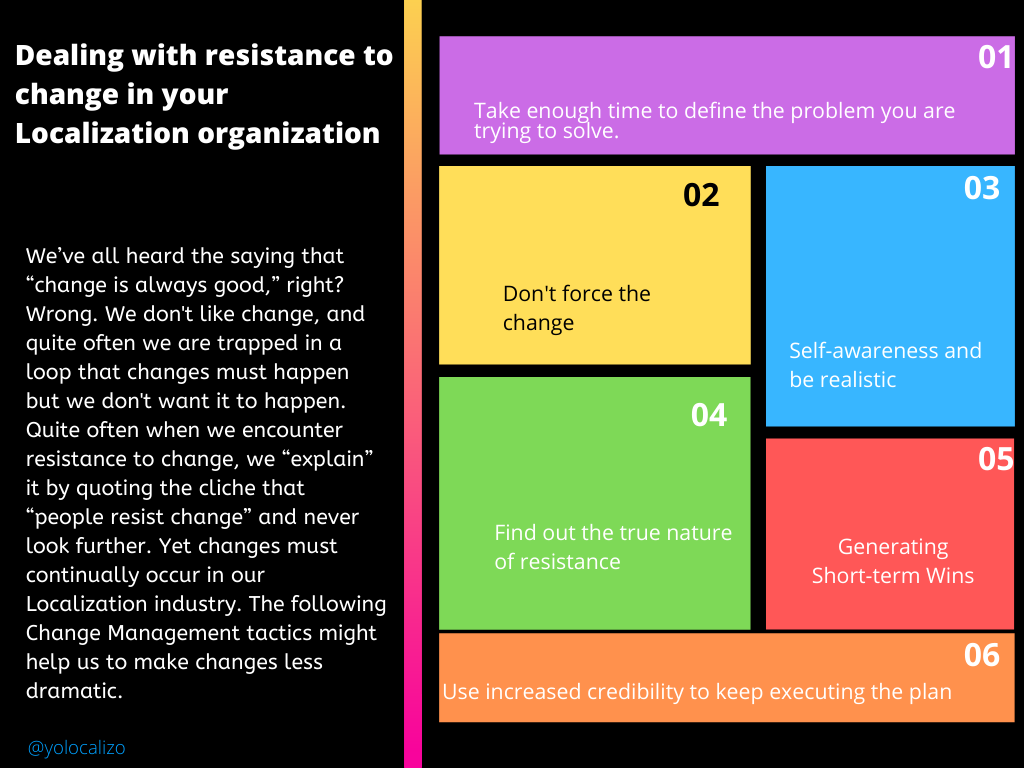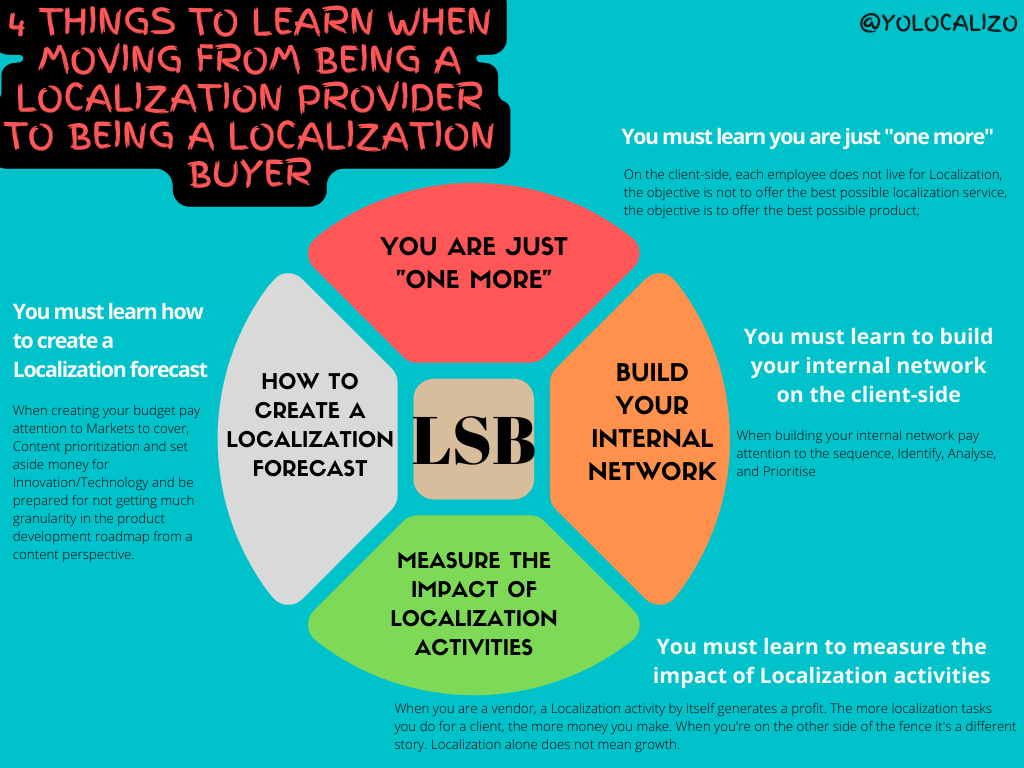4 things to learn when moving from being a Localization provider to being a Localization buyer
As a professional in the Localization industry, I have been working on the client side for about 15 years at this point in my career.
Before that, most of my projects were carried out as a service provider.
Back in 2006, I was working for Vodafone's smartphone division.
In that project, I oversaw the Localization and LQA tasks. One of the things that struck me most in the first weeks in my new role was that my team, Localization, was just "one more" of the tasks to be done; my team, me, was just "one more."
This, in perspective, obviously makes sense; a Localization team is "one more" of the pieces needed to launch a product, but what struck me the most in those first meetings was that I had to explain many things related to Localization; from basic things like why we need a glossary, to more advanced stuff like the need to have a TMS to manage the content that would later become the text of the applications that the phone had installed.
"One more," what a strange feeling during the first months!
Although it is true that, in general terms, the tasks related to Localization, whether as a language service provider or as a localization buyer, have more similarities than differences, there are certain aspects, mainly from a mindset perspective, that must be considered so that the transition from provider to the buyer is carried out as effectively as possible.
In the following paragraphs, I will outline 4 aspects to consider if you are thinking about (or have recently moved) jumping the fence and working on the localization buyer side.
HERE to download the infographic
1.- You must learn you are just "one more"
As I anticipated in the previous paragraph, we must learn to be “one more” when working on the client-side.
But what does it mean to be "one more"?
When I worked on the vendor side, I remember my meetings with my former Lionbridge colleagues, in which sharing the context of how to carry out internationalization tasks or how to do TMs analysis, or how to approach DTP work, required minimal, sometimes no context; we would get straight into discussions of process improvements or how to be more efficient doing glossary management for customers, or what were the highest priority bugs to fix in those early morning Monday bug triage sessions.
In my LSP life, every employee lived by and for Localization; every member of every team; engineers, testers, sales, project managers, translators, solutions architects... each and every one of them understood the ins and outs of the localization world.
All that changes drastically when you work on the other side; you must give a lot of context, you have to explain what the I18N best practices are, you have to explain why context is needed for translators, and you have to explain that return of investment in Localization is not as easy to measure as you might think a priori...
There are many things to explain because we are just "one more".
On the client-side, each employee does not live for Localization, the objective is not to offer the best possible localization service, the objective is to offer the best possible product; of course, the localization tasks will have a direct impact on the user experience, but localization will only be "one more" of all the things we have to do well to make the best possible product.
2.- You must learn to build your internal network on the client side.
Being aligned at the vendor side may be easier because as I mentioned in the previous paragraph all LSP employees have a pretty good idea of what happens behind the scenes when localizing a product.
In the case of working on the client side, this is not the case; and that is why one of the most important things to do when moving to the client is to dedicate time and effort to building our internal network.
A Localization team interacts with many people in a day. A Localization team has many lines of communication and stakeholders to interact with.
This is great because it allows localization industry professionals to have a lot of visibility and opportunities to explain how the content we create and localize helps the overall growth of the company.
When building your internal network pay attention to the sequence, Identify, Analyse, and Prioritise
• Identify
Brainstorm to identify all the stakeholders that may be affected by the product you are localizing. Here we must include all of them, i.e. people/teams that influence our Localization program. Either at the active level, such as a web designer who asks us for the translation of the page he is creating, or passively the back-end developer who is configuring the server that will host the site.
• Analyze
Analyze the roles and expectations of the stakeholders. This will help to discover and determine how important are the stakeholders found and what is the degree of influence each one has in the project.
• Prioritize
The greater their influence and interest in the product, the greater our effort to incorporate them into the network we are building.
3.- You must learn to measure the impact of Localization activities
As a vendor, the impact of Localization is relatively easy to measure, and the company's profits are directly influenced by, the value of the localization service sold - minus the costs incurred to deliver that service (such as price per word, cost of technology, cost of having an
office, salaries...).
When you are "one more", how do you explain the impact your work has on the overall results of the company?
This is undoubtedly one of the most important tasks that someone who is customer-focused must learn to do.
When you are a vendor, a Localization activity by itself generates a profit. The more localization tasks you do for a client, the more money you make.
But when you're on the other side of the fence it's a different story. Localization alone does not mean growth.
Of course, Localization is important, and of course, it influences the overall results we achieve, but localization alone may not sell more; it is the combination of good Product Development+QA+Marketing+Localization+Customer Support that determines the global success or failure of a digital product.
Localization produces market enablement, but we cannot isolate international revenue and attribute all that revenue to the fact that the product is localized.
Learning how to measure the impact of Globalization is something I frequently cover in my blog. If you want to go deeper into this area this article, this other, and this other.
4.- You must learn how to create a Localization budget forecast
As buyers, around October the forecasting season starts! and learning how to create a budget that covers all the needs of the year ahead is something that I had to learn to do.
In many cases when you approach a Product Manager and ask what plans they have for content creation in the coming year, the most common response is a shrug of the shoulders.
Yes, it is quite likely that they have a product roadmap, but creating your localization budget from that roadmap will not be an easy task. In most cases that high-level description of a feature will be very generic and estimating its localization cost will not be easy; it is also likely that during the year you may decide to enter new markets, or do marketing campaigns for targeted local countries; therefore forecasting that monthly cost beforehand is tricky.
Budgeting from the client side is really complicated, it's a mix of relying on your experience and your instinct to bring high-level tasks to something more tangible that we can use to estimate the costs of your localization program for the coming year.
When creating your budget pay attention to these general guidelines, they will help you to come up with a total number for the year
Markets to cover
Understanding which markets are essential to your organization is fundamental when creating your budget as a buyer of localization services. Language prioritization is a factor to consider when making your forecast.
Content prioritization
The content we want to localize has different levels of visibility. Therefore we must take the time to analyze the content and its level of visibility. We might have a different localization strategy and quality expectations for marketing content vs technical documentation or FAQ and that obviously impacts the localization cost.
Innovation/Technology
Another element that we cannot overlook when creating a budget to cover localization expenses is to set aside some money to experiment with ways to bring our localization strategy to the next level, and taking it to the next level in this context means, testing tools, testing new processes, investing in innovation.
In summary
In the localization industry, moving from the supplier side to the buyer side certainly requires adapting to a way of working that is quite different, especially if you are working in a start-up that is creating its international expansion plan, and therefore does not have a localization team (or has a small team).
I hope the tactics and tips shared during this post can help you make the transition from one side to the other!
@yolocalizo














This post explores the key differences between working on the buyer versus the provider side of the localization industry. While there are some tasks common to both, others vary significantly in areas such as people management, operations, strategy, and metrics. The article breaks these tasks into four categories, providing examples for each to highlight these distinctions